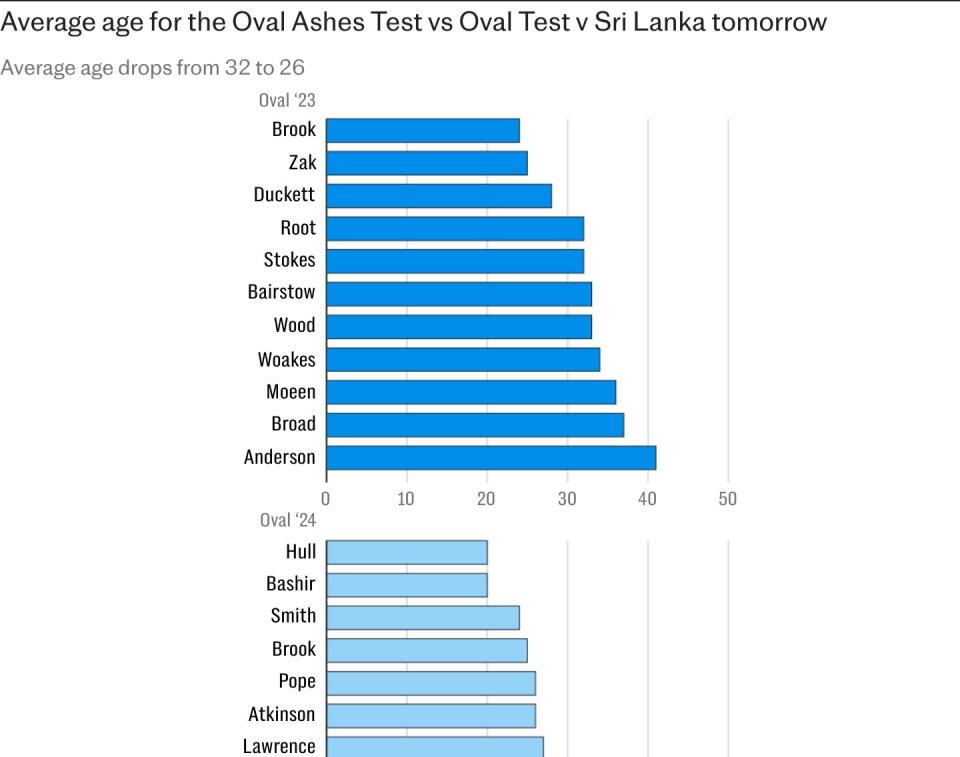
This morning at the Oval, Josh Hull will become England’s 716th Test cricketer. Hull’s maiden Test cap, aged 20, will encapsulate a summer of regeneration – a season in which English cricket’s talent pool, both at Test level and below, has been replenished.
Hull will join a Test side expecting to win every home game in a season for the first time since 2004. If this looming achievement cannot conceal that England’s summer has seldom been captivating, the campaign has witnessed a new generation of talent flowering.
The phenomenon is most obvious in the Test team. The first iteration of Bazball was largely shaped by outstanding performances from established players, newly liberated and emboldened. Jonny Bairstow’s extraordinary batting in 2022 was the catalyst for the new approach; James Anderson and Stuart Broad were both recalled, to great effect; Chris Woakes and Mark Wood helped to transform the 2023 Ashes.
Now, a new generation have been established. Last year at the Oval, England’s average age was 32; with only four survivors from that XI, the average age for this week’s Test has tumbled to 26.

In less than two months, uncapped players have become senior players, as if by osmosis. Gus Atkinson and Jamie Smith, who both made their Test debuts on July 10 at Lord’s, have shown such a combination of skills well suited to the international game and equable temperaments that they are both ensconced in the side.
Picking Hull fits within a guiding principle of England’s regeneration: focusing on a player’s attributes, not their domestic records. Hull has taken just 16 wickets at an average of 62.8 in 10 first-class games. Yet Brendon McCullum identified the Leicestershire bowler as a “rough diamond”, on account of his 6ft 7in height and left-arm angle.
Similar thinking led to Shoaib Bashir being picked to tour India at the start of the year with a first-class average of 67. Bashir, though still developing his craft to right-handers – he will appreciate the rough created by Hull’s footmarks – has performed solidly after usurping Jack Leach as first-choice spinner. Leach remains Somerset’s first-choice, but to England such considerations are moot: they regard the attributes required to succeed in county and Test cricket as completely different.
Similar thinking will now permeate the white-ball side, especially after McCullum’s appointment as all-format coach. A drab performance in the T20 World Cup in June brought an end to Matthew Mott’s tenure, following a run of three victories in 12 games against Test opponents in the last two World Cups.
As they extend their spirit of regeneration to limited-overs cricket too, England’s T20 squad for the series against Australia, which begins on Wednesday, includes six players uncapped in the format. Twenty-year-old Jacob Bethell, a Warwickshire left-hander with a high backlift and abundant self-belief, is perhaps the most effervescent.
Yet, for all the focus upon the England side, the sense of regeneration extends to county cricket. This is most obvious in the children of the 2005 Ashes side making their way in the shires: 16-year-old Rocky Flintoff at Lancashire and 18-year-old Archie Vaughan at Somerset.
Other teenagers are also thriving. Farhan Ahmed, the 16-year-old brother of Rehan, took 10 wickets on his County Championship debut for Nottinghamshire against Surrey last week. In the same game, 19-year-old Fred McCann hit 154 from number three. Durham’s 19-year-old opener Ben McKinney has an attacking game tailor-made for England’s requirements; much is also expected of Warwickshire’s 18-year-old middle-order batsman Hamza Shaikh. Derbyshire’s 17-year-old Harry Moore might one day be Ben Stokes’s successor as a seam-bowling all-rounder.
The new spate of teenagers in county cricket is due to more than their own talent. They are also beneficiaries of broader shifts in English cricket.
The first is the Metro Bank One-Day Cup. While the competition has been marginalised, with leading players appearing in the Hundred instead, there has been one unexpected benefit. “From a player development perspective, the One-Day Cup has provided opportunities,” says David Court, England’s player identification and talent pathway lead. Strong performances from young players in the One-Day Cup have then earned selection in the County Championship, too.
The second shift is better alignment of England’s pathway teams below the senior side. England use the Lions, their second string, as a way to accelerate the development of players of potential, regardless of their county records. The England Lions team who crushed Sri Lanka last month included Ahmed and Shaikh, who were both making their first-class debuts. “That progression from Young Lions to Lions to the senior team is as close as it’s ever been,” Court believes. “We are identifying players with a similar mindset and approach to those we need in the national team.”
The third shift is the England national team’s power of example. “England have leaned towards younger, optimistic picks,” Court says. “So there’s a chance for young players to progress quickly through the system, without necessarily having years in county cricket.”

England’s promotion of youth in international cricket has shown up counties’ historic conservatism, encouraging them to embrace teenage kicks, too. Once England had already made Rehan Ahmed the youngest Test player in their history, and seen him take seven wickets on debut, Notts making his younger brother Farhan their youngest-ever County Championship cricketer seemed altogether risky.
As he begins his new role as coaching supremo, the regeneration of talent has convinced McCullum that England should be challenging India for global cricket domination in all formats.
“Great talent sits within English cricket and it’s about realising that talent and bringing it together,” McCullum says ahead of the final Test against Sri Lanka. “With the passion for the game in this country, with the history and tradition for the game, the fact that it’s incredibly well-supported, the talent structure and pool that sits within this country, there’s no reason why it can’t be challenging India in that regard for all the major titles. There’s no reason why not.”
And so a summer in which cricket has struggled for attention could yet have an enduring legacy. The season of 2024 might be seen as a year of profound regeneration – and the time when English cricket, once and for all, learned to shake off its mistrust of youth.
Article courtesy of
Source link